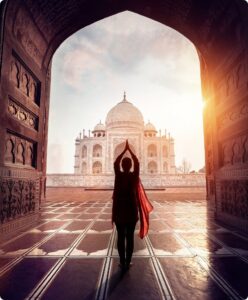Explore the glance of North India
 Discover your destination with us!
Discover your destination with us!

North India is a geographical and broad, but loosely defined cultural region comprising the northern part of India (or historically, the Indian subcontinent) wherein Indo-Aryans (speaking Indo-Aryan languages) form the prominent majority population. It extends from the Himalayan mountain range in the north to the Indo-Gangetic plains, the Thar Desert, the Central Highlands and the northwestern part of the Deccan plateau. It occupies nearly three-quarters of the area and population of India and includes all of the three mega cities of India: Delhi, Mumbai and Kolkata. In a more specific and administrative sense, North India can also be used to denote the Indo-Gangetic Plain within this broader expanse, stretching from the Ganga-Yamuna Doab to the Thar Desert.
Several major rivers flow through the region including the Indus, the Ganges, the Yamuna and the Narmada rivers. North India includes the states of Himachal Pradesh, Uttarakhand, Punjab and Haryana, Rajasthan, Uttar Pradesh, Madhya Pradesh, Chhattisgarh, Goa, Gujarat, Maharashtra, Bihar, Jharkhand, and West Bengal and union territories of Chandigarh, Delhi, Jammu and Kashmir and Ladakh. In its narrower administrative sense, the term has varying implications (see below) with different states included being Haryana, Himachal Pradesh, Punjab, Uttarakhand, Uttar Pradesh and Rajasthan and union territories of Chandigarh, Delhi, Jammu and Kashmir and Ladakh.
Indo-Aryans, who today form a majority in North India, Pakistan and Bangladesh, are descendants of the Indo-Iranians who migrated from Central Asia via the Bactria-Margiana Culture into this region between 2000 BC and 1500 BC after the collapse of the Indus Valley Civilisation. There was a slow migration of Indo-Iranian peoples through the northwest leading to the development of the Indo-Aryan languages from Proto-Indo-Iranian and minor vocal synthesis with the Dravidian languages. North India was the historical centre of the ancient Vedic culture, the Mahajanapadas, and Magadha Empire, the medieval Delhi Sultanate and the modern Mughal India and Indian Empire, among many others.
It has a diverse culture, and includes the Hindu pilgrimage centres of Char Dham, Haridwar, Varanasi, Ayodhya, Mathura, Prayagraj, Vaishno Devi and Pushkar, the Buddhist pilgrimage centres of Sarnath and Kushinagar, the Sikh Golden Temple as well as world heritage sites such as the Nanda Devi Biosphere Reserve, Khajuraho temples, Hill Forts of Rajasthan, Jantar Mantar (Jaipur), Qutb Minar, Red Fort, Agra Fort, Fatehpur Sikri and the Taj Mahal. North India’s culture developed as a result of interaction between these Hindu and Muslim religious traditions.
The heart of India lies in its people, their warmth, and the myriad traditions that color everyday life. Immerse yourself in the vivacity of Indian festivals, whether it’s the colorful celebration of Holi or the sparkling lights of Diwali. Indulge in the diverse culinary delights, from aromatic street food to rich and flavorful regional cuisines that reflect the country’s culinary heritage.
Best Selling North India Tour Packages
Hola Namaste is all about forging connections – with diverse cultures, hidden gems and community. We curate experiences that go beyond the touristy façade, offering you a chance to immerse yourself in the heart and soul of the places you visit!
Rajasthan
Himachal
Uttarakhand
Uttar Pradesh
Delhi
Ladakh

Experience local activites
Create unforgettable memories

